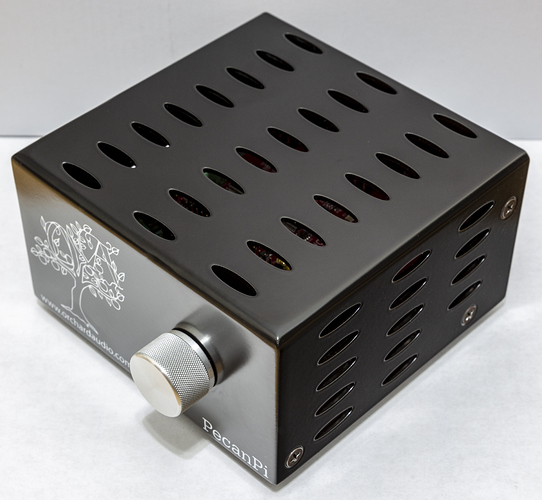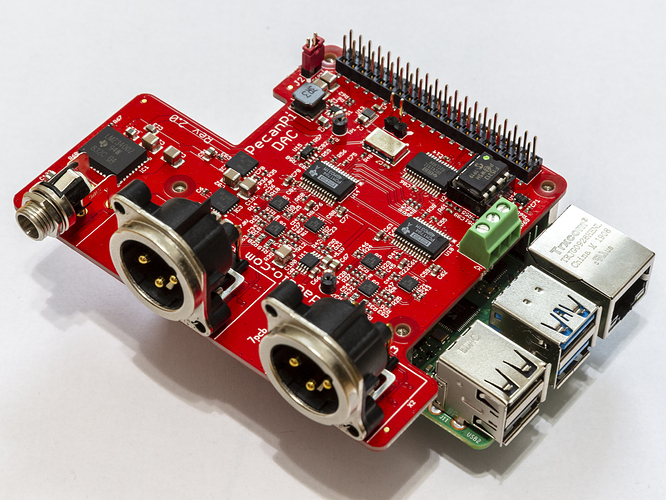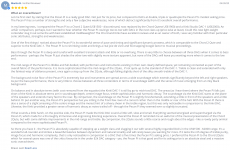PecanPi products are now in stock and shipping within a few days.
You can get 15% off your order by posting a review to the product page. (This cannot be combined with any other offers/discounts)
Shop | Orchard Audio
You can get 15% off your order by posting a review to the product page. (This cannot be combined with any other offers/discounts)
Shop | Orchard Audio
I would like to ask one question,
why do you use PCM1794a, when you can have PCM1792A, which can do DSD native up to DSD256? I remember the SRC4193 ASRC have bypass function, so DSD signal can pass through that with no problem.
The Rpi does not have a DSD output.
It only happens once a season — our Pi Day Sale! Use code “piday314” at checkout on 3/14-3/15 and get $31.4 off your order.
https://orchardaudio.com/shop?olsPage=products


https://orchardaudio.com/shop?olsPage=products


The PecanPi® line of products has been upgraded for 2020.
Published test results here.
Members of this forum get $35 off any purchase by using code: “sale35off”




Published test results here.
Members of this forum get $35 off any purchase by using code: “sale35off”
The PecanPi® line of products has been upgraded for 2020.
Published test results here.
Members of this forum get $35 off any purchase by using code: “sale35off”
The volume knob on both the dac/streamer and pecanpi-USB is a nice touch.
About the power input, I notice there's no center pin notation. I assume it is standard pin-out and not inverted? (typically this is indicated on enclosure)
Is there any sense in using a medical 9v supply ? I suppose it is immediately fed into a switcher and/or regulators?
Kind regards
The volume knob on both the dac/streamer and pecanpi-USB is a nice touch.
About the power input, I notice there's no center pin notation. I assume it is standard pin-out and not inverted? (typically this is indicated on enclosure)
Is there any sense in using a medical 9v supply ? I suppose it is immediately fed into a switcher and/or regulators?
Kind regards
Center pin is positive.
The 9V from the input power supply does not power anything directly, it gets regulated to a bunch of other supplies. All critical supplies are linear regulators.
Center pin is positive.
The 9V from the input power supply does not power anything directly, it gets regulated to a bunch of other supplies. All critical supplies are linear regulators.
Thanks.
Another great customer review...
Much more impressive than a sub-$500 unit has the right to be!
Wow! As an owner of three digital to analog music systems - the SOtM Ultra Trio, Allo's Kantana with two TeraDak LPSs, and now Orchard's PecanPi, it is amazing to me just how good the all in one end point units have become. Summary - The PecanPi is a no-brainer purchase for anyone looking to stream hi-resolution music to their stereo system. The Allo Kantana, the unit my PecanPi will now replace, was no slouch and an excellent unit in its own right...but, there are a number of things I like better about the PecanPi.
But before I go into a comparison between the similarly priced Allo Kantana and the PP, I have to disclaim the advantages the Allo Kantana had during this comparison (to an off the shelf PecanPi). a) The Kantana was powered with two TeraDak LPS (which added about $300 to the base cost). The PecanPi was set-up in its base form, which is what Leo recommends. When I bought my Kantana a year ago, purchase of external LPS was highly recommended and I can state 1st hand that the Kantana improved vastly with the addition of each of the two LPS units. The standalone Kantana was lifeless and blurred without LPSs. b) The Kantana was connected with a Kimber KCAG RCA interconnect during the comparison versus the PP equipped with a much less expensive/reviewed LFD RCA interconnect. NOTE: I can hardly wait to hear the PP with its native balanced XLR outputs.
My subjective, comparative impressions (and why I believe the PP is an incredible value):
1) Soundstage - the sound stage thrown by the PP is incredible. Immediately noticeable and quite a benefit if you speakers cannot have optimal placement. With this, the depth of the stage and instrument separation seem to be more precisely placed. The Kantana had what I thought at the time was a great soundstage, but the PP was exceptionally better at this.
2) Ease of listening and midrange delight - the vocals produced by the PP are easy, emotional, and delightful. While the Kantana has its own unique way of producing great sound and range, the PP is just more pleasurable to listen to over extended periods.
3) Ease of set-up and support - this clearly goes to the PP without question. Set-up was simple, well-explained and for the single question that I had for Leo, my answer came within minutes. Allo support was coming from India and whilst it was not bad, it is a world of difference with Orchard Audio. My pontification on this subject is as follows - when one gets into the sub-$500 USD price range, the support for a complex digital component is not set-up to deal with individuals that lack a basic computer skill knowledge and ability to search forums and follow detailed instructions...a point my 26 YO continually reminds me of . The PP is a unit that I could easily set-up and run. The Allo on the other hand, required considerably different skills and knowledge...that of a 26 YO CS Major.
4) Build Quality - The PP comes in a self-contained steel enclosure that while quite light, is study and substantial when compared to the Allo Kantana's plastic assembly. The Kantana feels fragile, exposed and flimsy by comparison to the PP. The Kantana is quite easily moved around by the weight of the wires and has exposed electronic parts. Both structurally and aesthetically the PP is an 9/10 and the Allo is a 4/10.
5) Accessories - the PP is built with balanced XLR outputs and Orchard provides a pair of his proprietary RCA adapters for those requiring single ended inputs. Balanced is a big plus for me although all my listening to date has been single-ended RCA. Orchard provides a 3.5mm headphone jack for a very modest charge, allowing those who wish to use headphones to connect in.
I am really blown away with the quality, versatility, and sound of Orchard's PP. It is a magnificent leap forward for digital audio and without question a steal at its price.
Please note: I paid for my unit, just like everyone else. My review here was just to provide my personal insights into affordable hi-end audio.
System used to evaluate (because this always comes up) - Roon Nucleaus Server streaming to PP with LFD Spiroflex single-ended interconnects + Allo Kantanta (w/2 TeraDak LPS). The units are connected to an LFD Mk IV SE integrated amplifier connected with LFD Grainless speaker wires to Meadowlark Kestral Hot Rod speakers.
Orchard Audio - Audio Player, Streamer | Orchard Audio
Much more impressive than a sub-$500 unit has the right to be!
Wow! As an owner of three digital to analog music systems - the SOtM Ultra Trio, Allo's Kantana with two TeraDak LPSs, and now Orchard's PecanPi, it is amazing to me just how good the all in one end point units have become. Summary - The PecanPi is a no-brainer purchase for anyone looking to stream hi-resolution music to their stereo system. The Allo Kantana, the unit my PecanPi will now replace, was no slouch and an excellent unit in its own right...but, there are a number of things I like better about the PecanPi.
But before I go into a comparison between the similarly priced Allo Kantana and the PP, I have to disclaim the advantages the Allo Kantana had during this comparison (to an off the shelf PecanPi). a) The Kantana was powered with two TeraDak LPS (which added about $300 to the base cost). The PecanPi was set-up in its base form, which is what Leo recommends. When I bought my Kantana a year ago, purchase of external LPS was highly recommended and I can state 1st hand that the Kantana improved vastly with the addition of each of the two LPS units. The standalone Kantana was lifeless and blurred without LPSs. b) The Kantana was connected with a Kimber KCAG RCA interconnect during the comparison versus the PP equipped with a much less expensive/reviewed LFD RCA interconnect. NOTE: I can hardly wait to hear the PP with its native balanced XLR outputs.
My subjective, comparative impressions (and why I believe the PP is an incredible value):
1) Soundstage - the sound stage thrown by the PP is incredible. Immediately noticeable and quite a benefit if you speakers cannot have optimal placement. With this, the depth of the stage and instrument separation seem to be more precisely placed. The Kantana had what I thought at the time was a great soundstage, but the PP was exceptionally better at this.
2) Ease of listening and midrange delight - the vocals produced by the PP are easy, emotional, and delightful. While the Kantana has its own unique way of producing great sound and range, the PP is just more pleasurable to listen to over extended periods.
3) Ease of set-up and support - this clearly goes to the PP without question. Set-up was simple, well-explained and for the single question that I had for Leo, my answer came within minutes. Allo support was coming from India and whilst it was not bad, it is a world of difference with Orchard Audio. My pontification on this subject is as follows - when one gets into the sub-$500 USD price range, the support for a complex digital component is not set-up to deal with individuals that lack a basic computer skill knowledge and ability to search forums and follow detailed instructions...a point my 26 YO continually reminds me of . The PP is a unit that I could easily set-up and run. The Allo on the other hand, required considerably different skills and knowledge...that of a 26 YO CS Major.
4) Build Quality - The PP comes in a self-contained steel enclosure that while quite light, is study and substantial when compared to the Allo Kantana's plastic assembly. The Kantana feels fragile, exposed and flimsy by comparison to the PP. The Kantana is quite easily moved around by the weight of the wires and has exposed electronic parts. Both structurally and aesthetically the PP is an 9/10 and the Allo is a 4/10.
5) Accessories - the PP is built with balanced XLR outputs and Orchard provides a pair of his proprietary RCA adapters for those requiring single ended inputs. Balanced is a big plus for me although all my listening to date has been single-ended RCA. Orchard provides a 3.5mm headphone jack for a very modest charge, allowing those who wish to use headphones to connect in.
I am really blown away with the quality, versatility, and sound of Orchard's PP. It is a magnificent leap forward for digital audio and without question a steal at its price.
Please note: I paid for my unit, just like everyone else. My review here was just to provide my personal insights into affordable hi-end audio.
System used to evaluate (because this always comes up) - Roon Nucleaus Server streaming to PP with LFD Spiroflex single-ended interconnects + Allo Kantanta (w/2 TeraDak LPS). The units are connected to an LFD Mk IV SE integrated amplifier connected with LFD Grainless speaker wires to Meadowlark Kestral Hot Rod speakers.
Orchard Audio - Audio Player, Streamer | Orchard Audio
@orchardaudio is there anyway to stack an amp on top of the Pecan PI DAC?
I am new to the raspberry PI so don't know how the GPIO pinouts work and if the system works like a FPGA where outputs can be assigned.
Can the PECAN DAC have the outputs assigned to the GPIOs?
The outputs of the PecanPi do not physically go to the GPIO.
iFi Audio just released an update version of iPower, the "X". iFi Audio calims that the noise floor is 1uV. I bought one and tried it on my PecanPi streamer. Unfortunately I can't hear any difference. Not better not worse. Does anyone here ever do the same? Or have you tried anything else and get a better result?
iFi Audio just released an update version of iPower, the "X". iFi Audio calims that the noise floor is 1uV. I bought one and tried it on my PecanPi streamer. Unfortunately I can't hear any difference. Not better not worse. Does anyone here ever do the same? Or have you tried anything else and get a better result?
I am not surprised by this observation.
Stuff like that is a waste of money with the PecanPi, this is because internally it already has built-in ultra-low noise linear power supplies. So having an external linear power supply will not make any difference as opposed to a switching one that I provide.
Properly designed equipment should take care of the power supply internally and should not depend on external filters and LPS for best performance.
iFi Audio just released an update version of iPower, the "X". iFi Audio calims that the noise floor is 1uV. I bought one and tried it on my PecanPi streamer. Unfortunately I can't hear any difference. Not better not worse. Does anyone here ever do the same? Or have you tried anything else and get a better result?
The power goes straight into voltage switcher/regulator
I also find the standard pecanpi power supply quite nice. At least it uses a rugged IEC power connector on one side as opposed to the cheap wall wart kind of supplies.
A great review by Hans Beekhuyzen:
Orchard Audio PecanPi streamer/DAC - YouTube
Orchard Audio PecanPi streamer/DAC - YouTube
Will RoPieeeXL run on this without issue?
Yes. both Ropieee and Ropieee XL run with no issues.
- Home
- Vendor's Bazaar
- PecanPi -- Next Generation Raspberry Pi DAC and Streamer
